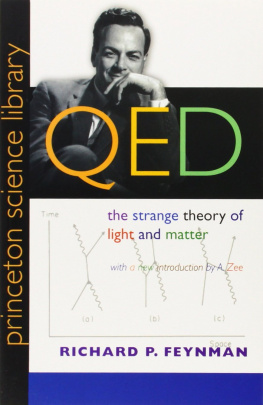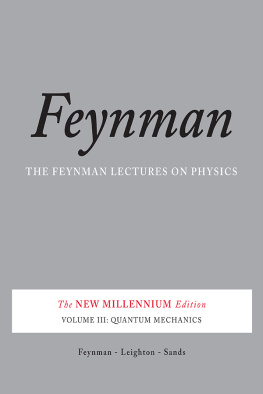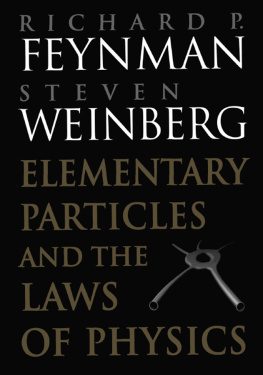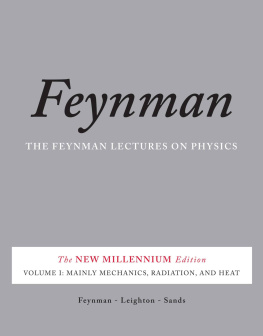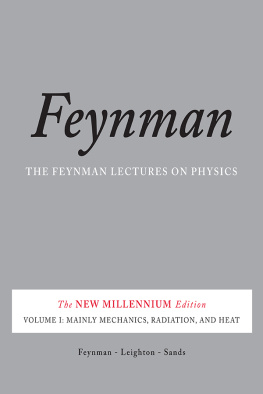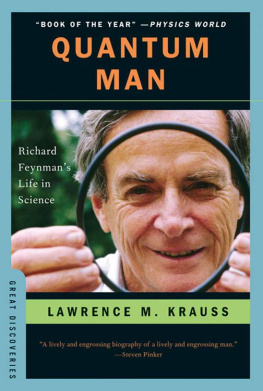QED
ALIX G. MAUTNER
MEMORIAL LECTURES
QED
THE STRANGE THEORY OF
LIGHT AND MATTER
RICHARD P. FEYNMAN
With a new introduction by A. Zee
PRINCETON UNIVERSITY PRESS
PRINCETON AND OXFORD
Copyright 1985 by Richard P. Feynman
New introduction by A. Zee Copyright 2006 by Princeton University Press
Requests for permission to reproduce material from this work should be sent to Permissions, Princeton University Press
Published by Princeton University Press,
41 William Street, Princeton, New Jersey 08540
In the United Kingdom: Princeton University Press,
3 Market Place, Woodstock, Oxfordshire OX20 1SY
All Rights Reserved
First printing, 1985
First Princeton Science Library Edition, 1988
Expanded Princeton Science Library Edition, with a new introduction by A. Zee, 2006
Library of Congress Control Number 2005934342
ISBN-13: 978-0-691-12575-6 (paperback)
ISBN-10: 0-691-12575-9 (paperback)
ISBN-13: 978-0-691-12717-0 (cloth)
ISBN-10: 0-691-12717-4 (cloth)
This book has been composed in Linotron Baskerville
Printed on acid-free paper.
pup.princeton.edu
Printed in the United States of America
7 9 10 8 6
original epub MD5: 417cdd815548eb6f879c51573562622a
epub revised on 05-May-2019 16:46
Contents
by A. Zee |
by Leonard Mautner |
by Ralph Leighton |

A unique example of one of Feynmans famous diagrams, inscribed and signed by Feynman himself; image appears courtesy of Jay M. Pasachoff, Field Memorial Professor of Astronomy at Williams College, for whom the diagram was drawn in the front pages of his first-edition copy of QED.
Introduction to the 2006 Edition
The story of how we came to know light makes for one gripping drama, complete with twists and turns and reversals of fortune.
The photon is the most visible of all elementary particles: place yourself in a dusty room with one small window open on a sunny day and watch a multitude of the little buggers hurrying across the room. Newton quite naturally thought that light consisted of a stream of particles (corpuscles), but already he had some doubts; even in the seventeenth century, the diffraction of light could be readily observed. Eventually, diffraction and other phenomena appeared to show without doubt that light is an electromagnetic wave. That monument of nineteenth-century physics, Maxwells equations of electromagnetism, formulated light entirely as a wave. Then Einstein came along and explained the photoelectric effect by postulating light as the sum of little packets (quanta) of energy. Thus were the word photon and the quantum theory of light born. (Here I will not digress and recall Einsteins famous discomfort with quantum mechanics, even though he helped at its birth.) Meanwhile, from the 1920s through the 1940s physicists worked out the quantum behavior of matter (atoms) thoroughly. Thus, it was all the more puzzling that the quantum behavior of light and its interaction with electrons resisted the efforts of the best and the brightest, notably Paul Dirac and Enrico Fermi. Physics had to wait for three young menFeynman, Schwinger, and Tomonagafilled with optimism and pessimism, as the case may be, from their experiences in World War II, to produce the correct formulation of quantum electrodynamics, aka QED.
Richard Feynman (19181988) was not only an extraordinary physicist, but also an extraordinary figure, a swash-buckling personality the likes of which theoretical physics has not seen before or hence. Occasionally theoretical physicists will while away an idle moment comparing the contributions of Feynman and Schwinger, both nice Jewish boys from New York and almost exact contemporaries. This senseless discussion serves no purpose, but it is a fact that while Julian Schwinger was a shy and retiring person (but rather warm and good-hearted behind his apparent remoteness), Dick Feynman was an extreme extrovert, the stuff of legends. With his bongo drums, showgirls, and other trappings of a carefully cultivated image enthusiastically nurtured by a legion of idolaters, he is surely the best-loved theoretical physicist next to Einstein.
The brilliant Russian physicist Lev Landau famously had a logarithmic scale for ranking theoretical physicists, with Einstein on top. It is also well known that Landau moved himself up half a step after he formulated the theory of phase transitions. I have my own scale, one of fun, on which I place theoretical physicists I know either in person or in spirit. Yes, it is true: most theoretical physicists are dull as dishwater and rank near minus infinity on this logarithmic scale. I would place Schrdinger (about whom more later) on top, but Feynman would surely rank close behind. I cant tell you where I land on my own scale, but I do try to have as much fun as possible, limited by the amount of talent and resources at my disposal.
But what fun Feynman was! Early in my career, Feynman asked me to go to a nightclub with him. One of Feynmans colleagues told me that the invitation showed that he took me seriously as a physicist, but while I was eager to tell Feynman my thoughts about Yang-Mills theory, he only wanted my opinion on the legs of the dancing girls on stage. Of course, in the psychology of hero worship, nobody gives two hoots about some bozo of a physicist who plays drums and likes showgirls. So all right, my scale is really fun times talentLandaus scale with fun factored in, with the stock of Einstein falling and that of Landau rising (he played some good pranks until the KGB got him).
Now some thirty years after that night club visit, I felt honored that Ingrid Gnerlich of Princeton University Press should ask me to write an introduction to the 2006 edition of Feynmans famous book QED: The Strange Theory of Light and Matter. First a confession: I had never read QED before. When this book came out in 1985 I had just finished writing my first popular physics book, Fearful Symmetry, and I more or less adopted a policy of not reading other popular physics books for fear of their influencing my style. Thus, I read the copy Ingrid sent me with fresh eyes and deep appreciation. I enjoyed it immensely, jotting down my thoughts and critiques as I went along.
I was wrong not to have read this book before, because it is not a popular physics book in the usual sense of the phrase. When Steve Weinberg suggested in 1984 that I write a popular physics book and arranged for me to meet his editor in New York, he gave me a useful piece of advice. He said that most physicists who wrote such books could not resist the urge of explaining everything, while the lay reader only wanted to have the illusion of understanding and to catch a few buzzwords to throw around at cocktail parties.
I think that Weinbergs view, though somewhat cynical, is largely correct. Witness the phenomenal success of Hawkings A Brief History of Time (which I have not read in accordance with the policy I mentioned earlier). One of my former colleagues here at the University of California, a distinguished physicist who now holds a chair at Oxford, once showed me a sentence from that book. The two of us tried to make sense of it and failed. In contrast, I want to assure all the puzzled readers that every sentence in this book, though seemingly bizarre to the max, makes sense. But you must mull over each sentence carefully and try hard to understand what Feynman is saying before moving on. Otherwise, I guarantee that you will be hopelessly lost. It is the physics that is bizarre, not the presentation. After all, the title promises a strange theory.
Next page
